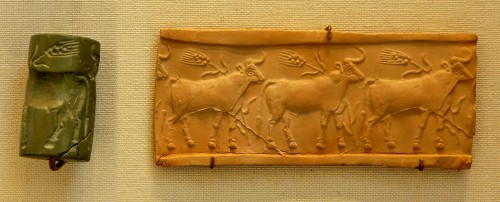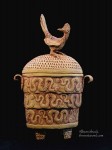Cylinder seals and castanets
 On the left is a green limestone cylinder seal and the impression it leaves in wet clay. Six thousand years ago, it hung around the neck of a Mesopotamian scribe or businessman. Now it’s now in the Louvre and despite a nasty crack you can see lovely stout beeves in a wheat field marching around it, very pastoral and comfy. This kind of seal was used all over the ancient Near East (what we now know as Iran, Iraq, Syria, Turkey, and other countries in the eastern Mediterranean and western Asia) to authenticate inventories and letters written on clay tablets, clay sealings on rooms, jars and parcels, bricks, and anything else needing a stamp of approval or ownership. A combination of archaic in material and modern in use, cylinder seals were the stone rubber stamp of their day, highly portable and personalized.
On the left is a green limestone cylinder seal and the impression it leaves in wet clay. Six thousand years ago, it hung around the neck of a Mesopotamian scribe or businessman. Now it’s now in the Louvre and despite a nasty crack you can see lovely stout beeves in a wheat field marching around it, very pastoral and comfy. This kind of seal was used all over the ancient Near East (what we now know as Iran, Iraq, Syria, Turkey, and other countries in the eastern Mediterranean and western Asia) to authenticate inventories and letters written on clay tablets, clay sealings on rooms, jars and parcels, bricks, and anything else needing a stamp of approval or ownership. A combination of archaic in material and modern in use, cylinder seals were the stone rubber stamp of their day, highly portable and personalized.
Clay’s property of taking detailed impressions when moist hasn’t changed over the millenia and potters, now as then, take advantage of it. Many Three Star Owl pieces, like Beastie Ware, are textured with cylinders I’ve carved in clay and then fired, giving me a way to pattern the clay just as distinct and personal as fingerprints.
The rattlers below get lots of use in making “Crotalus” items, like this oval jar with a roadrunner on the lid.
For etymology enthusiasts: Crotalus, a genus of North American pit vipers including many of our familiar rattlers, is derived from Greek krotalon (το κροταλον), a type of rattle or castanets held in the fingertips. They were used particularly by revelers of Dionysus, making the apt connection with rattlers both for their sound and their cthonic origins. Incidentally, I’ve read that Arizona has more species of rattlesnakes than any other US state.


